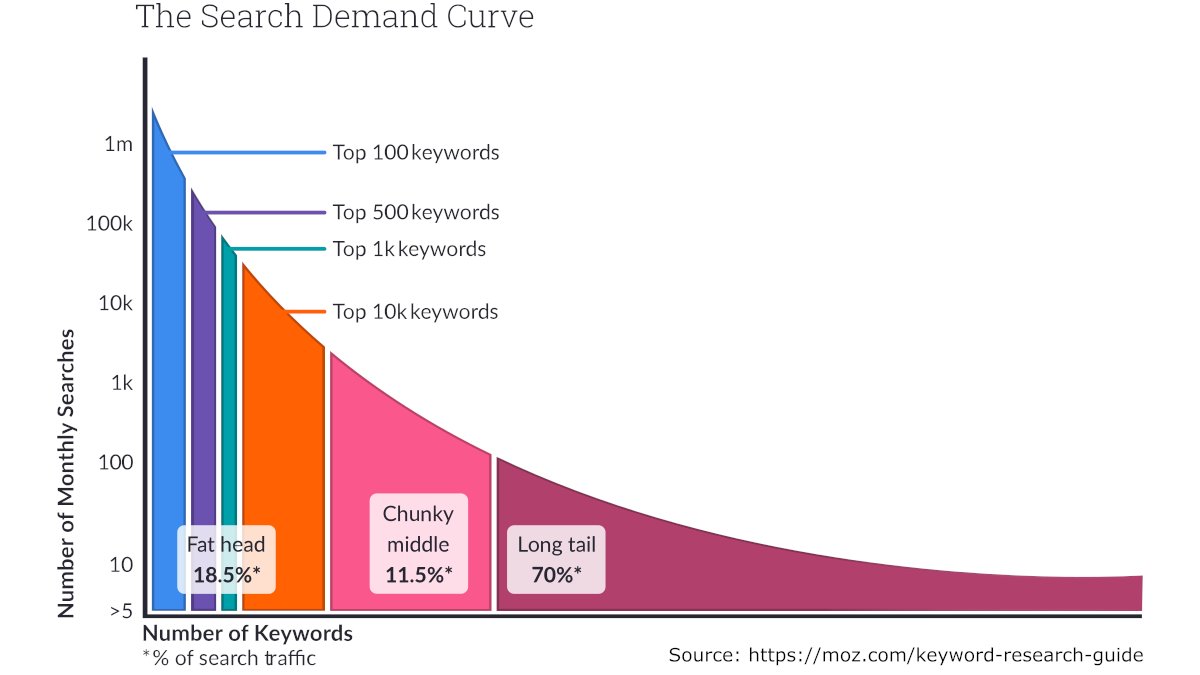If you feel like your niche is too small to reach effectively, don& #39;t give up! Narrow niche markets have unique #SEO benefits. Once you crawl to the top, you essentially own the niche.
These 6 steps from @krisjonescom and @sejournal will help get you to the top.
THREAD...
These 6 steps from @krisjonescom and @sejournal will help get you to the top.
THREAD...
STEP 1: Analyze Your Industry’s General Search Volume
1a) Google Keyword Planner is a good free tool for this, but it& #39;s not the only one. Ubersuggest by @neilpatel is another great free tool for discovering new keywords and keywords you already rank for: https://neilpatel.com/ubersuggest/ ">https://neilpatel.com/ubersugge...
1a) Google Keyword Planner is a good free tool for this, but it& #39;s not the only one. Ubersuggest by @neilpatel is another great free tool for discovering new keywords and keywords you already rank for: https://neilpatel.com/ubersuggest/ ">https://neilpatel.com/ubersugge...
1b) Snoop on your competition, too. See what they rank for and study what you can do to outrank them. The @semrush Keyword Gap tool is a great way to compare your domain against your competitors.
https://www.semrush.com/analytics/keywordgap/">https://www.semrush.com/analytics...
https://www.semrush.com/analytics/keywordgap/">https://www.semrush.com/analytics...
1c) Mine the SERPs. Here& #39;s how:
 https://abs.twimg.com/emoji/v2/... draggable="false" alt="👉" title="Right pointing backhand index" aria-label="Emoji: Right pointing backhand index">Manually look at the frontpage results for your keyword until you know the searcher& #39;s intent
https://abs.twimg.com/emoji/v2/... draggable="false" alt="👉" title="Right pointing backhand index" aria-label="Emoji: Right pointing backhand index">Manually look at the frontpage results for your keyword until you know the searcher& #39;s intent
 https://abs.twimg.com/emoji/v2/... draggable="false" alt="👉" title="Right pointing backhand index" aria-label="Emoji: Right pointing backhand index">Look at snippets
https://abs.twimg.com/emoji/v2/... draggable="false" alt="👉" title="Right pointing backhand index" aria-label="Emoji: Right pointing backhand index">Look at snippets
 https://abs.twimg.com/emoji/v2/... draggable="false" alt="👉" title="Right pointing backhand index" aria-label="Emoji: Right pointing backhand index">Click through the top 10 results and see what type of content they have
https://abs.twimg.com/emoji/v2/... draggable="false" alt="👉" title="Right pointing backhand index" aria-label="Emoji: Right pointing backhand index">Click through the top 10 results and see what type of content they have
Take notes and include similar content in your articles.
Take notes and include similar content in your articles.
STEP 2: Keyword Research
2a) Focus on keywords that match user intent. If you& #39;re selling a product, include keywords with transactional intent, but don& #39;t forget long-tail keywords. @answerthepublic is a unique tool for finding long-tail Q&A queries: https://answerthepublic.com/ ">https://answerthepublic.com/">...
2a) Focus on keywords that match user intent. If you& #39;re selling a product, include keywords with transactional intent, but don& #39;t forget long-tail keywords. @answerthepublic is a unique tool for finding long-tail Q&A queries: https://answerthepublic.com/ ">https://answerthepublic.com/">...
2b) Long-tail keywords are longer search phrases with fewer (but more than zero) monthly queries. They generally have lower search competition.
@Moz has a very thorough guide on keyword research and long-tail keywords:
https://moz.com/keyword-research-guide">https://moz.com/keyword-r...
@Moz has a very thorough guide on keyword research and long-tail keywords:
https://moz.com/keyword-research-guide">https://moz.com/keyword-r...
2c) The keyword generator from @ahrefs is probably the best tool for identifying long-tail keywords around a central theme. Enter a word or two, then look for long-tail results.
https://ahrefs.com/keyword-generator">https://ahrefs.com/keyword-g...
https://ahrefs.com/keyword-generator">https://ahrefs.com/keyword-g...
2d) Using inanchor and intitle searches in @Google is an underused way to truly gauge keyword competition. It goes something like this:
 https://abs.twimg.com/emoji/v2/... draggable="false" alt="🔸" title="Small orange diamond" aria-label="Emoji: Small orange diamond">inanchor:"your keyword"
https://abs.twimg.com/emoji/v2/... draggable="false" alt="🔸" title="Small orange diamond" aria-label="Emoji: Small orange diamond">inanchor:"your keyword"
 https://abs.twimg.com/emoji/v2/... draggable="false" alt="🔸" title="Small orange diamond" aria-label="Emoji: Small orange diamond">intitle:"your keyword"
https://abs.twimg.com/emoji/v2/... draggable="false" alt="🔸" title="Small orange diamond" aria-label="Emoji: Small orange diamond">intitle:"your keyword"
Fewer results = better chance of ranking.
The more monthly queries, the better.
Fewer results = better chance of ranking.
The more monthly queries, the better.
STEP 3: Incorporate Keywords on Your Website
3a) Once you& #39;ve settled on a keyword list, start creating optimized content on your site centered around these keywords. How do you optimize your content?
...
3a) Once you& #39;ve settled on a keyword list, start creating optimized content on your site centered around these keywords. How do you optimize your content?
...
3b) Place your keywords in your
 https://abs.twimg.com/emoji/v2/... draggable="false" alt="➡️" title="Rightwards arrow" aria-label="Emoji: Rightwards arrow">Page Title
https://abs.twimg.com/emoji/v2/... draggable="false" alt="➡️" title="Rightwards arrow" aria-label="Emoji: Rightwards arrow">Page Title
 https://abs.twimg.com/emoji/v2/... draggable="false" alt="➡️" title="Rightwards arrow" aria-label="Emoji: Rightwards arrow">Meta Description
https://abs.twimg.com/emoji/v2/... draggable="false" alt="➡️" title="Rightwards arrow" aria-label="Emoji: Rightwards arrow">Meta Description
 https://abs.twimg.com/emoji/v2/... draggable="false" alt="➡️" title="Rightwards arrow" aria-label="Emoji: Rightwards arrow">Body Content
https://abs.twimg.com/emoji/v2/... draggable="false" alt="➡️" title="Rightwards arrow" aria-label="Emoji: Rightwards arrow">Body Content
 https://abs.twimg.com/emoji/v2/... draggable="false" alt="➡️" title="Rightwards arrow" aria-label="Emoji: Rightwards arrow">Header Tags
https://abs.twimg.com/emoji/v2/... draggable="false" alt="➡️" title="Rightwards arrow" aria-label="Emoji: Rightwards arrow">Header Tags
 https://abs.twimg.com/emoji/v2/... draggable="false" alt="➡️" title="Rightwards arrow" aria-label="Emoji: Rightwards arrow">URL
https://abs.twimg.com/emoji/v2/... draggable="false" alt="➡️" title="Rightwards arrow" aria-label="Emoji: Rightwards arrow">URL
 https://abs.twimg.com/emoji/v2/... draggable="false" alt="➡️" title="Rightwards arrow" aria-label="Emoji: Rightwards arrow">Graphics (image alt and title text)
https://abs.twimg.com/emoji/v2/... draggable="false" alt="➡️" title="Rightwards arrow" aria-label="Emoji: Rightwards arrow">Graphics (image alt and title text)
STEP 4: Create Great Content
4a) Remember when you mined the SERP results in Step 1c? https://abs.twimg.com/emoji/v2/... draggable="false" alt="☝️" title="Up pointing index" aria-label="Emoji: Up pointing index">You did that for a reason. Model your content around existing successful pages, but do yours better. Be informative and write to your audience the way they were intending (match search intent)
https://abs.twimg.com/emoji/v2/... draggable="false" alt="☝️" title="Up pointing index" aria-label="Emoji: Up pointing index">You did that for a reason. Model your content around existing successful pages, but do yours better. Be informative and write to your audience the way they were intending (match search intent)
4a) Remember when you mined the SERP results in Step 1c?
4b) Put a strong focus on readability and properly format your content. #digitalmarketing becomes a lot easier once you build authority with an error-free site. @Grammarly will help ensure your content remains clear and error-free: https://www.grammarly.com/ ">https://www.grammarly.com/">...
4c) Don& #39;t make walls of text. Incorporate visual elements and other mediums, like video, into your posts. If you don& #39;t have #GraphicDesign skills, use @canva. They have free graphic design tools and free courses to help develop your eye for visual design: https://www.canva.com/ ">https://www.canva.com/">...
4d) Remember to apply the long-tail keyword tricks you learned in Step 3 to each of your articles. Your keyword optimized content is how you& #39;ll pass your competition in the SERPs.
Keyword-optimized content with good #branding for your business is a bonus. Think infographics.
Keyword-optimized content with good #branding for your business is a bonus. Think infographics.
4e) Jump to the top of the SERPs with featured snippets. Google& #39;s featured snippets frequently come from pages outside the top 3 in the SERPs. Including lists and tables can help.
@michalpecanek and @ahrefs describe how to optimize for featured snippets: https://ahrefs.com/blog/find-featured-snippets/">https://ahrefs.com/blog/find...
@michalpecanek and @ahrefs describe how to optimize for featured snippets: https://ahrefs.com/blog/find-featured-snippets/">https://ahrefs.com/blog/find...
STEP 5: Perform Technical SEO
5a) There are 3 main areas to focus on for technical #SEO:
 https://abs.twimg.com/emoji/v2/... draggable="false" alt="1⃣" title="Keycap digit one" aria-label="Emoji: Keycap digit one"> Site Audit
https://abs.twimg.com/emoji/v2/... draggable="false" alt="1⃣" title="Keycap digit one" aria-label="Emoji: Keycap digit one"> Site Audit
 https://abs.twimg.com/emoji/v2/... draggable="false" alt="2⃣" title="Keycap digit two" aria-label="Emoji: Keycap digit two"> Mobile-Friendliness
https://abs.twimg.com/emoji/v2/... draggable="false" alt="2⃣" title="Keycap digit two" aria-label="Emoji: Keycap digit two"> Mobile-Friendliness
 https://abs.twimg.com/emoji/v2/... draggable="false" alt="3⃣" title="Keycap digit three" aria-label="Emoji: Keycap digit three"> Website Security
https://abs.twimg.com/emoji/v2/... draggable="false" alt="3⃣" title="Keycap digit three" aria-label="Emoji: Keycap digit three"> Website Security
5a) There are 3 main areas to focus on for technical #SEO:
5b) The SEO Spider Tool from @screamingfrog is one of the best tools for performing site audits. It gives you data on things like broken pages, mixed protocols and meta data issues on your site. Run it & fix any problems. Page speed is also important.
 https://abs.twimg.com/emoji/v2/... draggable="false" alt="🐸" title="Frog face" aria-label="Emoji: Frog face">
https://abs.twimg.com/emoji/v2/... draggable="false" alt="🐸" title="Frog face" aria-label="Emoji: Frog face">
https://www.screamingfrog.co.uk/ ">https://www.screamingfrog.co.uk/">...
https://www.screamingfrog.co.uk/ ">https://www.screamingfrog.co.uk/">...
5c) Since Google crawls with mobile-first indexing in mind, you MUST make sure your site is mobile-friendly. @getbootstrap by @fat and @mdo is a responsive, beautiful and flexible #webdesign theme perfect for SEO. https://getbootstrap.com/ ">https://getbootstrap.com/">...
5d) Sites that are SSL secure receive an SEO boost from Google. Google has made it clear they favor secure https sites over unsecure sites. If you don& #39;t have an SSL certificate, install one at once. @letsencrypt has free SSL certificates:
 https://abs.twimg.com/emoji/v2/... draggable="false" alt="🔐" title="Closed lock with key" aria-label="Emoji: Closed lock with key"> https://letsencrypt.org/ ">https://letsencrypt.org/">...
https://abs.twimg.com/emoji/v2/... draggable="false" alt="🔐" title="Closed lock with key" aria-label="Emoji: Closed lock with key"> https://letsencrypt.org/ ">https://letsencrypt.org/">...
STEP 6: Build Your Link Profile
6a) For this step, make sure your existing backlink profile is clean. Check your profile with backlink-checkers like @ahref or @Linkody. If your profile is spammy, disavow links with @googlewmc Search Console.
 https://abs.twimg.com/emoji/v2/... draggable="false" alt="🔗" title="Link symbol" aria-label="Emoji: Link symbol">
https://abs.twimg.com/emoji/v2/... draggable="false" alt="🔗" title="Link symbol" aria-label="Emoji: Link symbol">
https://ahrefs.com/backlink-checker">https://ahrefs.com/backlink-...
6a) For this step, make sure your existing backlink profile is clean. Check your profile with backlink-checkers like @ahref or @Linkody. If your profile is spammy, disavow links with @googlewmc Search Console.
https://ahrefs.com/backlink-checker">https://ahrefs.com/backlink-...
6b) @craigcampbell03 compares a bunch of these tools in the link below so take a look at it if you& #39;re not sure which one is best for you.
https://www.craigcampbellseo.com/website-backlink-analysis/
His">https://www.craigcampbellseo.com/website-b... Backlink King hoodie proves he& #39;s backlink royalty https://abs.twimg.com/emoji/v2/... draggable="false" alt="👇" title="Down pointing backhand index" aria-label="Emoji: Down pointing backhand index">
https://abs.twimg.com/emoji/v2/... draggable="false" alt="👇" title="Down pointing backhand index" aria-label="Emoji: Down pointing backhand index">
https://www.craigcampbellseo.com/website-backlink-analysis/
His">https://www.craigcampbellseo.com/website-b... Backlink King hoodie proves he& #39;s backlink royalty
6c) Link building is hard, but you don& #39;t need to (and shouldn& #39;t) beg for backlinks. @brianclark from @copyblogger offers better strategies for natural link-building, including:
 https://abs.twimg.com/emoji/v2/... draggable="false" alt="1⃣" title="Keycap digit one" aria-label="Emoji: Keycap digit one"> Guest Posting
https://abs.twimg.com/emoji/v2/... draggable="false" alt="1⃣" title="Keycap digit one" aria-label="Emoji: Keycap digit one"> Guest Posting
 https://abs.twimg.com/emoji/v2/... draggable="false" alt="2⃣" title="Keycap digit two" aria-label="Emoji: Keycap digit two"> Podcast Interviews
https://abs.twimg.com/emoji/v2/... draggable="false" alt="2⃣" title="Keycap digit two" aria-label="Emoji: Keycap digit two"> Podcast Interviews
 https://abs.twimg.com/emoji/v2/... draggable="false" alt="3⃣" title="Keycap digit three" aria-label="Emoji: Keycap digit three"> Tribal Content https://copyblogger.com/get-links/ ">https://copyblogger.com/get-links...
https://abs.twimg.com/emoji/v2/... draggable="false" alt="3⃣" title="Keycap digit three" aria-label="Emoji: Keycap digit three"> Tribal Content https://copyblogger.com/get-links/ ">https://copyblogger.com/get-links...
Full article from @sejournal and @krisjonescom  https://abs.twimg.com/emoji/v2/... draggable="false" alt="👉" title="Right pointing backhand index" aria-label="Emoji: Right pointing backhand index"> https://www.searchenginejournal.com/seo-niche-markets/351286/
https://abs.twimg.com/emoji/v2/... draggable="false" alt="👉" title="Right pointing backhand index" aria-label="Emoji: Right pointing backhand index"> https://www.searchenginejournal.com/seo-niche-markets/351286/
Thanks">https://www.searchenginejournal.com/seo-niche... for reading!
Thanks">https://www.searchenginejournal.com/seo-niche... for reading!
If you enjoyed this thread, please share it. We want to show what it& #39;s really like to start an online business from scratch so we designed a competition. We need 16 writers, graphic designers, web developers & other freelancers to form this year& #39;s teams.
https://cohoist.com/ ">https://cohoist.com/">...
https://cohoist.com/ ">https://cohoist.com/">...

 Read on Twitter
Read on Twitter
 " title="6b) @craigcampbell03 compares a bunch of these tools in the link below so take a look at it if you& #39;re not sure which one is best for you. https://www.craigcampbellseo.com/website-b... Backlink King hoodie proves he& #39;s backlink royalty https://abs.twimg.com/emoji/v2/... draggable="false" alt="👇" title="Down pointing backhand index" aria-label="Emoji: Down pointing backhand index">" class="img-responsive" style="max-width:100%;"/>
" title="6b) @craigcampbell03 compares a bunch of these tools in the link below so take a look at it if you& #39;re not sure which one is best for you. https://www.craigcampbellseo.com/website-b... Backlink King hoodie proves he& #39;s backlink royalty https://abs.twimg.com/emoji/v2/... draggable="false" alt="👇" title="Down pointing backhand index" aria-label="Emoji: Down pointing backhand index">" class="img-responsive" style="max-width:100%;"/>



